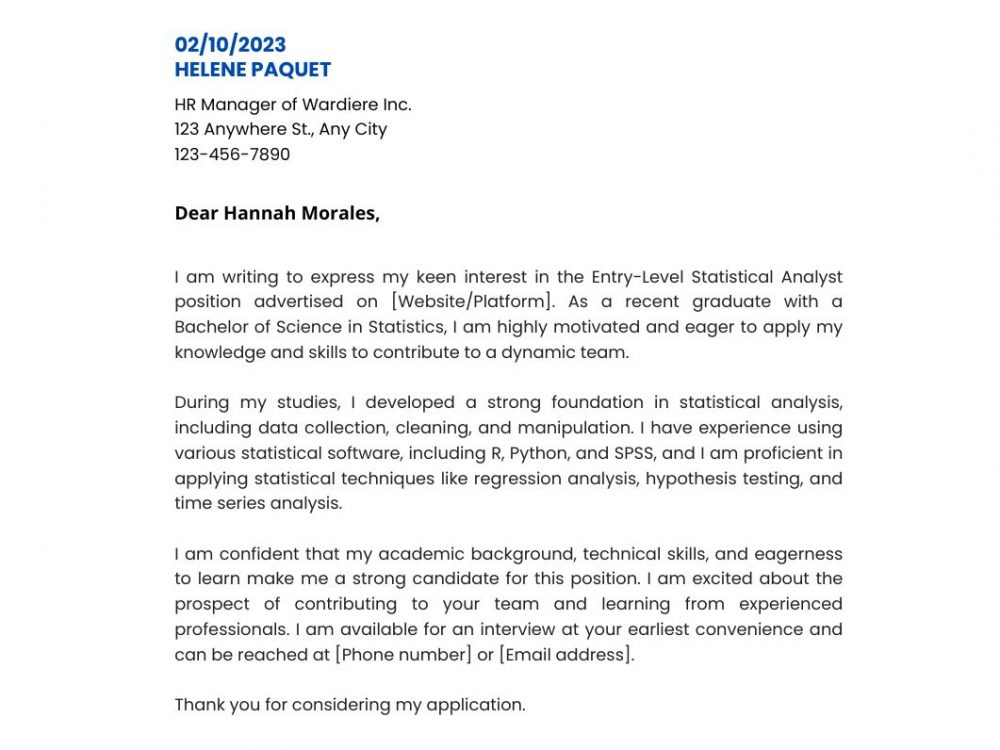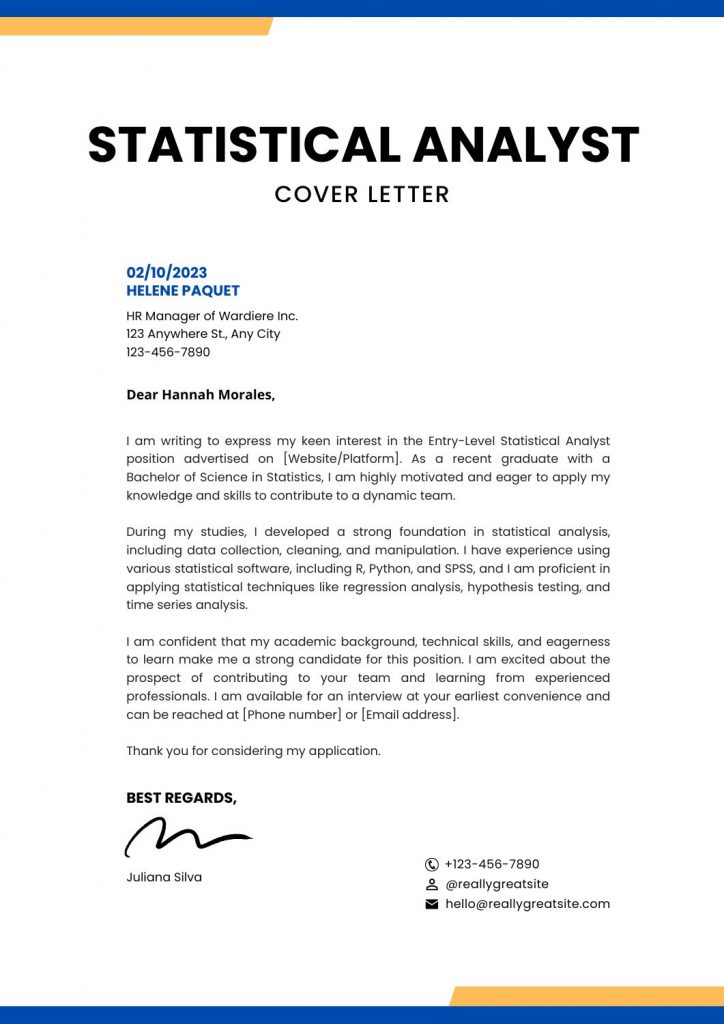
Looking for an engaging and persuasive cover letter for a Statistical Analyst position in 2023? Look no further! In this comprehensive guide, we will provide you with examples and templates to help you write an effective cover letter that stands out.

Are you a Statistical Analyst seeking new job opportunities in 2023? When it comes to job applications, a well-crafted cover letter is essential to showcase your skills, experiences, and achievements. A strong cover letter can help you stand out from other candidates and increase your chances of landing your dream job.
In this comprehensive guide, we will provide you with examples and templates for writing an engaging and persuasive cover letter specifically tailored for a Statistical Analyst position. Whether you are an experienced professional or just starting out in this field, our tips and techniques will help you create a compelling cover letter that captivates potential employers.
How to Write a Statistical Analyst Cover Letter

Writing an effective cover letter for a Statistical Analyst position involves following a clear structure and including relevant information that showcases your qualifications, accomplishments, and enthusiasm for the role.
Objective of a Statistical Analyst Cover Letter:
The objective of your cover letter is to:
- Introduce yourself and express your interest in the position
- Highlight your relevant experience and skills
- Show how you can contribute to the organization’s goals
- Convey your enthusiasm and commitment to the industry
- Demonstrate your attention to detail and analytical mindset
Key Components for Statistical Analyst Cover Letters:
A strong cover letter for a Statistical Analyst position should include the following key components:
- Contact Information: Include your name, address, phone number, and email address at the top of the cover letter.
- Salutation: Address the recipient with a professional greeting, such as “Dear Hiring Manager” or “Dear [Company Name] Recruitment Team.”
- Introduction Paragraph: Begin with a brief introduction that states your name, the position you are applying for, and your enthusiasm for the opportunity. Mention how you learned about the job opening and briefly touch on any relevant achievements or experiences.
- Body Paragraphs: Use 2-3 paragraphs to highlight your skills, experiences, and qualifications. Focus on specific accomplishments and projects that demonstrate your expertise in statistical analysis, data manipulation, and problem-solving. Use bullet points or concise, persuasive language to grab the reader’s attention.
- Closing Paragraph: Conclude your cover letter by expressing gratitude for the opportunity to apply and reiterating your interest in the role. Mention that you would welcome the opportunity to discuss your qualifications further and provide your contact information for potential employer follow-up.
- Formal Closing: Use a professional closing, such as “Sincerely” or “Best Regards,” followed by your full name.
- Signature: Sign your name in between the closing and your printed name. If the cover letter will be sent electronically, you can type your name instead.
Statistical Analyst Cover Letter Format:
A well-structured cover letter ensures clarity and readability. Here is a suggested format to follow:
Contact Information
Salutation
Introduction Paragraph
Body Paragraphs
-Bullets
Closing Paragraph
Formal Closing
Signature
Tips for Writing Your Statistical Analyst Cover Letter
To increase the effectiveness of your statistical analyst cover letter, keep the following tips in mind:
- Tailor Your Cover Letter: Customize your cover letter for each job application, showcasing the skills and experiences that are most relevant to the position.
- Emphasize Your Analytical Skills: Highlight your expertise in statistical analysis, data manipulation, and problem-solving. Provide specific examples of projects or initiatives where you applied these skills.
- Quantify Your Achievements: Whenever possible, use quantifiable metrics and data to demonstrate the impact of your work. This will help showcase your abilities in a tangible way.
- Demonstrate Your Knowledge: Show that you are familiar with relevant statistical software, methodologies, and industry trends. This will convey your commitment and enthusiasm for the field.
- Address Employment Gaps: If you have any employment gaps or unique circumstances, address them briefly in your cover letter. Focus, however, on how your skills and experiences qualify you for the position.
- Keep It Concise and Professional: Limit the length of your cover letter to one page maximum, ensuring that it remains clear and easy to read. Use professional language and a formal tone throughout.
- Proofread Before Sending: Review your cover letter for any errors in spelling, grammar, or formatting. A mistake-free cover letter demonstrates attention to detail and professionalism.
How Long Should a Cover Letter Be for a Statistical Analyst?
As mentioned earlier, a strong statistical analyst cover letter should be no longer than one page. Choose your words carefully to ensure that your message is impactful and does not overwhelm the reader. A concise and to-the-point cover letter shows the hiring manager that you respect their time and value their attention.
How Do I Write a Cover Letter for a Statistical Analyst with No Experience?
If you are a recent graduate or have limited experience as a Statistical Analyst, you can still create a compelling cover letter. Highlight your educational background including relevant coursework, internships, research projects, or any other related activities. Focus on your technical skills, analytical mindset, and eagerness to learn and grow within the industry.
Key Takeaways
Crafting an effective cover letter is essential when applying for a Statistical Analyst position. By following the tips and guidelines provided in this guide, you can create a well-structured and persuasive cover letter that highlights your qualifications and enthusiasm for the role. Tailor your cover letter to each specific job application, showcase your analytical skills, and use quantifiable examples to support your claims. Finally, ensure your cover letter is error-free and reflects your professionalism and attention to detail.
By investing time and effort into your cover letter, you increase your chances of impressing potential employers and securing the Statistical Analyst job you desire.
